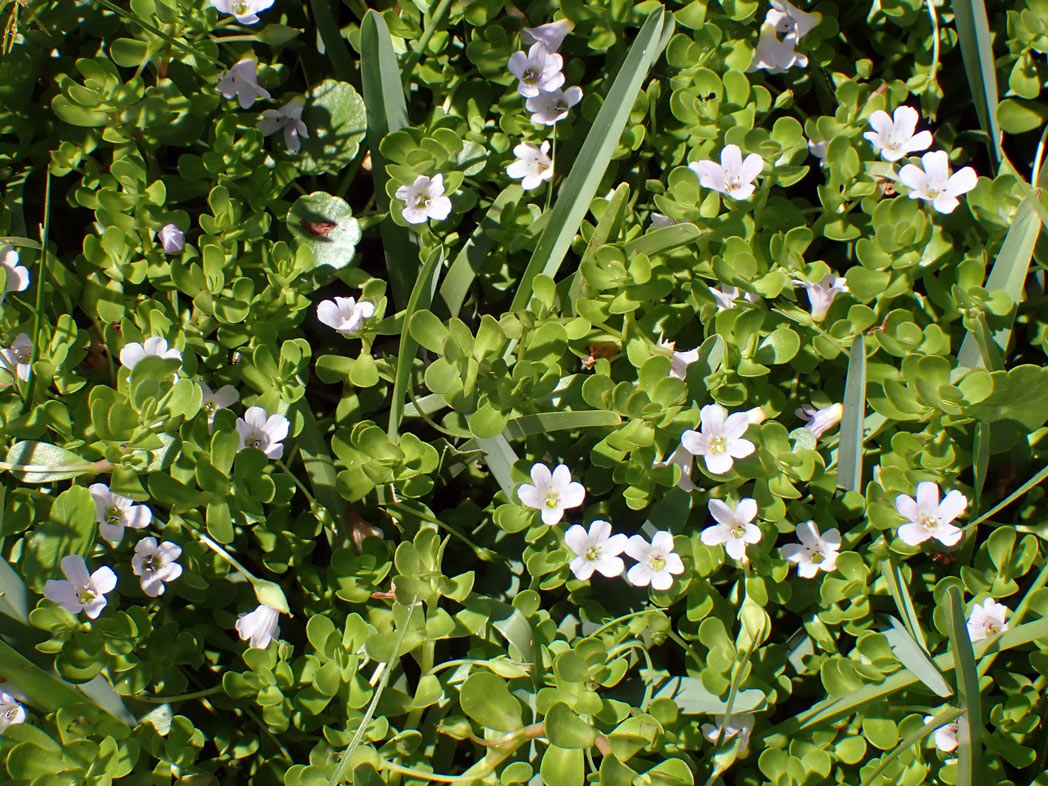Herb-of-grace
Pictured above: Herb-of-grace (Bacopa monnieri) by Ali and Brice (CC BY-NC). Click on terms for botanical definitions. View post as a PDF.
Also known as Water hyssop, Herb-of-grace is a creeping, mat-forming perennial that occurs naturally in coastal hammocks and swales, swamps, salt and freshwater marshes, and along river, stream and ditch edges. It typically blooms spring through fall, but may bloom year-round. It attracts a variety of small pollinators, and is a larval host plant for the White peacock butterfly.
The pinkish-white flowers are bell-shaped and five-lobed with a violet center. Each has four stamens and five sepals. Flowers are axillary with small stalks. The bloom’s center is violet. Leaves are sessile, obovate to spatulate, and succulent. They are oppositely arranged. Leaf margins are entire. Stems are succulent and bright green. Seeds are born in inconspicuous capsules.
Herb-of-grace has a similar appearance as its cousin, Lemon bacopa (Bacopa caroliniana), and is found in similar habitats. To differentiate them, crush a leaf. If you smell lemon, you know you have Lemon bacopa. Herb-of-grace will not emit a scent. Other distinguishing factors are Lemon bacopa’s purplish-blue flowers and clasping leaves. Both species were formerly classified in the Scrophulariaceae (figwort) family. Neither is related to Hyssop (Hyssopus sp.), which is in the Lamiaceae (mint) family.
The species epithet monniere pays homage to Louis-Guillaume Le Monnier (1717–1799), a French natural scientist.
Family: Plantaginaceae (Plantain family)
Native range: Nearly throughout
To see where natural populations of Herb-of-grace have been vouchered, visit florida.plantatlas.usf.edu.
Hardiness: 8B–11
Lifespan: Perennial
Soil: Moist to wet, well-drained to poorly drained organic soil
Exposure: Full sun
Growth habit: 1–3” tall and sprawling
Propagation: Seed, cuttings
Garden tips: In the right conditions, Herb-of-grace can make a nice groundcover, but it is a fast grower and may spread aggressively. It also works well in a container or hanging pot. The plant is moderately salt-tolerant, but does not tolerate long periods of drought. It can survive in partial sun, but does best when given plenty of sun and water. Herb-of-grace will generally die back in winter, although in southern Florida it can be evergreen.
Herb-of-grace plants are occasionally available from nurseries that specialize in Florida native plants. Visit www.PlantRealFlorida.org to find a nursery in your area.
For more information on other Bacopa species, see:

